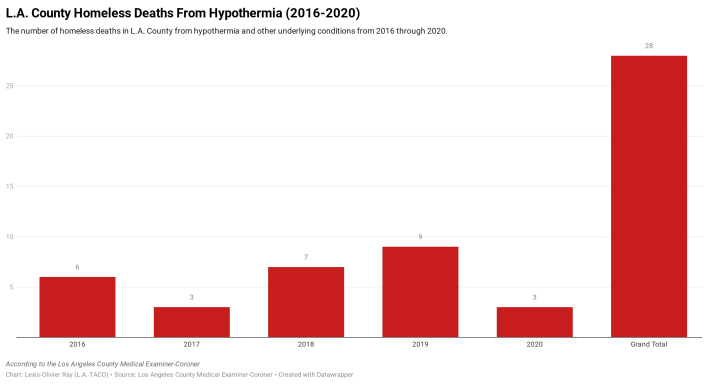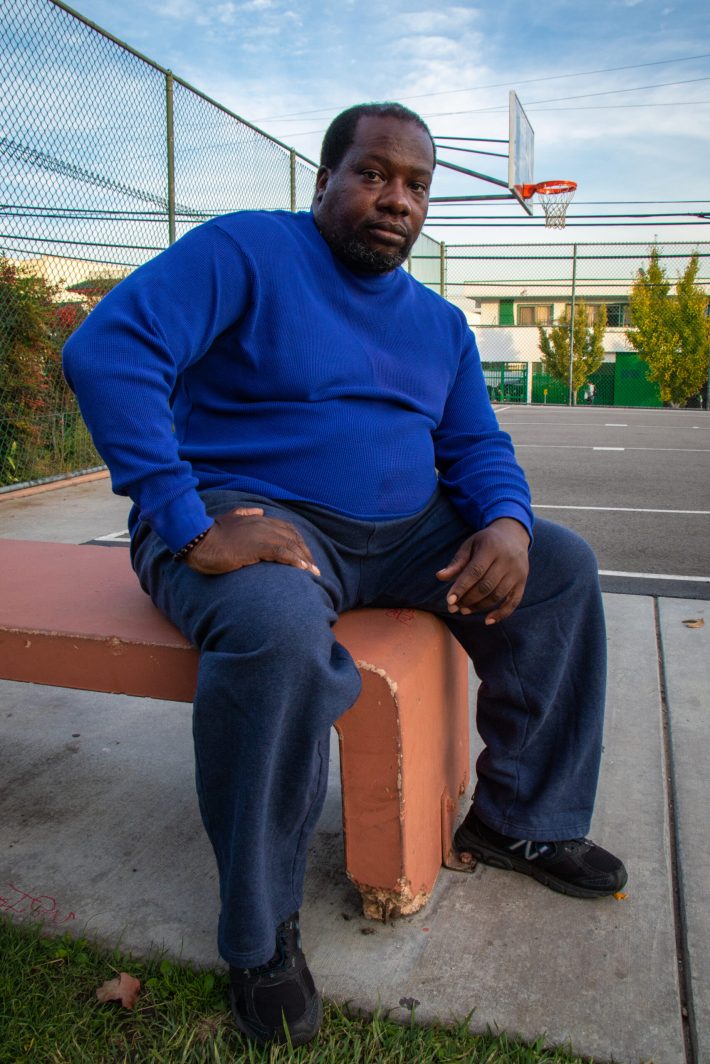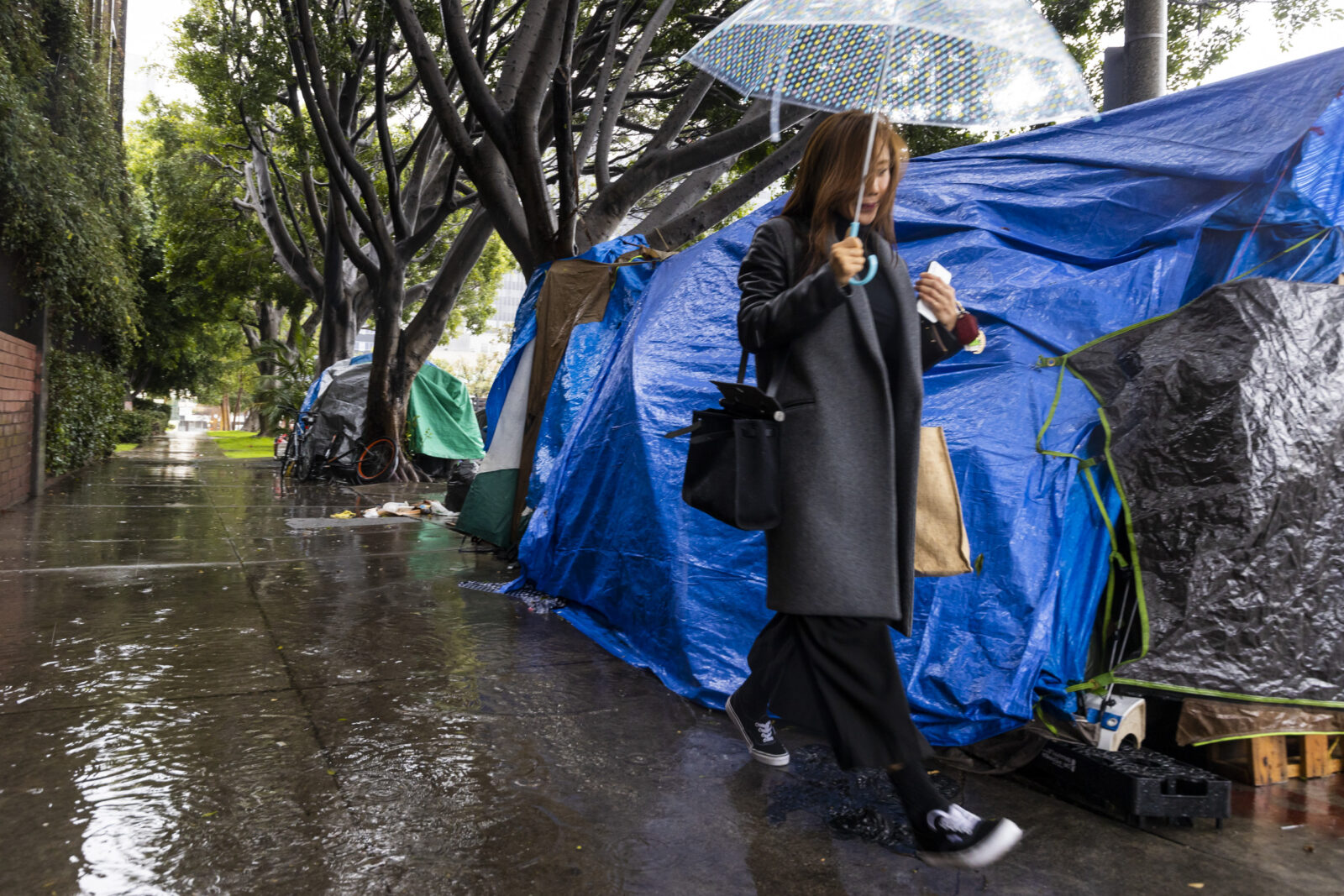It might be warm outside in Los Angeles when you read this but at night, early morning and during the coldest months of the year, parts of the county rank amongst the most frigid cities in the state.
This weekend, while parts of Southern California saw record high temperatures, powerful winds and even brush fires, temperatures in Lancaster, the most populous region of the Antelope Valley, ranged from as high as 70 degrees during the day to as low as 31 degrees at night and in the early morning. A cold weather advisory extending until January 22 has been issued for the region since mid-December when the Antelope Valley posted temperatures as low as 27 degrees.
Bouts of cold weather typically seen in Southern California around the new year—sometimes mixed with rain and or extreme winds—can be deadly for the largest unhoused community in the nation.

According to the Los Angeles County Medical Examiner-Coroner, since 2016, 28 of the tens of thousands of people experiencing homelessness in L.A. lost their lives due to hypothermia and other underlying conditions.
An L.A. Taco analysis found that almost all deaths involving hypothermia occurred in December, January, or February—typically the county’s coldest and wettest months of the year. And during years when it rained more, more unhoused people died.
Nearly half of all people experiencing homelessness that died from hypothermia and other underlying conditions since 2016 passed away during the first month of the year. In 2016, three unhoused people died in a four-day period in January, and in 2018, five unhoused people died during the first month of the year. December was the second deadliest month. In 2019, four unhoused people died between Christmas and New Year’s Eve.
Since 2019, 12 unhoused people have died from hypothermia in Los Angeles. By comparison, only two people died from hypothermia in San Francisco, a smaller county with roughly 1/10th of the homeless population, that rarely sees sunny skies or temperatures above 70 degrees, according to data obtained by L.A. Taco from the San Francisco Medical Examiner. The Los Angeles Times found that in 2018 more unhoused people died in Los Angeles than in New York and San Francisco combined.
In Los Angeles, homeless people died of hypothermia and other underlying conditions in parking lots, alleys, trailers, churches, and on sidewalks. In Pomona, West Covina, Canyon Country, Burbank, Downey, Long Beach, Lynwood, and DTLA. All but three descendants were men, the youngest was 27 years old, the oldest 67.
- On January 7, 2016 – 58-year-old Dane Clark was found in a parking lot down the street from a medical center, fire station, and a hospital in West Covina after three days of periodic rain. He died from being outside in cold rainy weather, malnutrition, and other health conditions. In addition to Clark, two other unhoused people died from hypothermia within a four-day span that year.
- On January 22, 2017 – the Long Beach Fire Department found 58-year-old Kelly Vanegas laying on her back on a sidewalk. It rained over three inches that day, more rain than Long Beach had seen in over a decade. When paramedics arrived on the scene, Vanegas was “cold to the touch and without blood pressure.” Vanegas arrived at Community Hospital of Long Beach at 4:20 PM. Fifteen minutes later, Vanegas died of “cardiac arrest due to hypothermia.”
- On January 10, 2018 – Carl McJimson was found in some bushes next to Transfiguration Church in South Los Angeles after a multi-day storm that dropped as much as four inches of rain in some areas of the county. McJimson was one of two unhoused people that died in a two-day period and one of five houseless people that died during January in 2018 from hypothermia and other underlying conditions.
- On January 20, 2018 – A witness saw 44-year-old Armando Illiceto alive. A day later they found him in the same position unresponsive. Illiceto was transported to the emergency room where he was diagnosed with hypothermia and a gastrointestinal bleed. The medical examiner’s report notes that Illiceto was cold to touch and had a very low blood pressure. While in the ICU, Illicit went “code blue.” Despite resuscitative measures, he never regained his pulse and was pronounced dead.
- Four days later – on January 25, 2018 – 42-year-old Denise Lutture was found at a bus bench behind a burger joint in Long Beach. Lutture died six minutes walking distance from a hospital.
- On December 5, 2018 – at around 4:30 PM, Leslie John Goodwin was found steps away from his tent, laying on his stomach with his face pressed into the dirt in a large, remote-encampment in the high desert by a friend who had stopped by to bring Goodwin a tarp. Goodwin’s friend told investigators that he had spoken to him a few days earlier and that Goodwin sounded like he was doing well. According to Goodwin’s sister, he suffered from a medical history of chronic epilepsy with seizures but because he was homeless he didn’t take medication. Roughly 15 minutes after his friend found him, L.A. County Fire Captain Kilpatrick pronounced the 56-year-old dead without medical intervention. His clothes were wet from recent rains and it was noted that his body was cold to touch. Temperatures in the Antelope Valley ranged from the high 30s to low 40s at the time, according to the medical examiner’s report.
- A day later, Charles Neighbors was found in wet and cold clothing by the Los Angeles Fire Department. According to the coroner’s report, Neighbors had a seizure in front of paramedics and shortly after that went into cardiac arrest. He was transferred to the now-shuttered St. Vincent Medical Center in Westlake where emergency room personnel continued resuscitative efforts. His wet clothing was removed and warming blankets were applied. About twenty minutes after he was found, Neighbors temperature was 95 degrees. ER staff was unable to resuscitate Neighbors and on December 6, 2018, he died of hypothermia due to exposure to the elements. At 67, Neighbors was the oldest person to die from hypothermia between 2016 and 2020.
- The day after Christmas in 2019, recycling center workers at Carranca Recycling Center found 52-year-old Nery Solis—an unhoused man that employees knew— unresponsive on a sidewalk near downtown. Solis had been complaining of flu-like symptoms for days, according to a report from the medical examiner. Carranca employees last saw Solis alive on Christmas evening. The following morning, after a night of heavy rains, Solis was found “soaking wet” next to an untouched plate of food, with his head resting on a wadded up blanket and his body uncovered, according to the medical examiner. An investigation noted that it was 48 degrees when Solis was found and 40 degrees the previous night. Solis was one of four unhoused people that died between Christmas day and New Year’s Eve in 2019.
- On April 8, 2020 – A nude Daniel Hays was found by paramedics near Grand Park in DTLA, groaning with a faint pulse. Hays was cold to the touch and according to the medical examiner likely suffered from a “phenomenon termed paradoxical undressing in which a person takes off their clothing because they feel hot even though they are actually hypothermic.” Hays died of coronary disease, cirrhosis, and probable hypothermia.
The combination of underlying health conditions (such as malnutrition, cardiovascular disease, infection) and homelessness makes the unhoused more likely to die from hypothermia, according to the Center for Disease Control.
Exposure to rain or high winds can also exacerbate hypothermia—the condition that occurs when a person's body temperature dips below 95 degrees. According to the Mayo Clinic, “Because water is very good at transferring heat from your body, body heat is lost much faster in cold water than in cold air. Similarly, heat loss from your body is much faster if your clothes are wet.” During years that it rained more—like in 2016, 2018, and 2019 when L.A. saw record amounts of precipitation after years of drought—more unhoused people died from hypothermia. An L.A. Taco analysis of 20 autopsy reports and data provided by the L.A. County Medical Examiner-Coroner found that more than a quarter of all decedent that died from hypothermia were discovered in the rain or with wet clothes including three unhoused people that died of hypothermia over four wet days during the first week of the New Year in 2016.
“If it starts raining you’ve got to secure your clothes,” MB, an unhoused man that earns a living repairing bikes on the border of Mid-City and Koreatown says on a warmer than usual, early-January afternoon. Born and raised in Los Angeles, like many native Angelenos, MB’s roots spread all over the city. His grandmother still lives in South Central but he grew up part-time at his Dad’s house on North Country Club Drive—a tree-lined street running through Mid-City’s Country Club Park, a neighborhood dotted with pre-war mansions and craftsman style homes. The once segregated community became a haven for Black musicians and civil rights leaders during the mid-20th century. “I never thought that I would be out here but shit happens you know, I just try to make it as positive as possible.”
MB says that the force of the rain makes it almost impossible to keep belongings dry, as the afternoon sun hits his face. It’s over 70 degrees when L.A. Taco interviews MB but at night, the temperature will drop nearly 30 degrees. “It’s warm right now but tonight the weather is going to flip, it’s going to be ice cold,” he says. According to the CDC, “Persons living in warm climates, high elevations, and areas with large daily temperature fluctuations, run a greater risk of catching hypothermia.”
Alcohol and drug use can also increase the risk of hypothermia and were listed as contributing factors in over 60 percent of deaths that L.A. Taco reviewed. According to the Mayo Clinic: “Alcohol may make your body feel warm inside, but it causes your blood vessels to expand, resulting in more rapid heat loss from the surface of your skin. The body's natural shivering response is diminished in people who've been drinking alcohol.” Drugs can impact a person's judgement.
“I had nothing. I didn't have a blanket. And I was so cold, I was scrambling trying to find boxes or newspapers or anything to warm myself. That was the longest, scariest night because I had to really stay awake...”
Even if it doesn’t lead to death, bedding down in a thinly lined tent on the sidewalk or in a crammed vehicle poses other health risks. A lower than normal body temperature can also be a sign of pneumonia. MB says that people who don’t prep themselves for the dramatic range in temperature often get sick.
In the midst of a surging global pandemic, options for people with nowhere to go still remain minimal during the coldest months of the year. According to the Los Angeles Homeless Services Authority (LAHSA), there are 16 winter shelter sites operating from October 2020 to March 2021, as well as six “augmented winter shelters” that activate when there are two or more days below 50 degrees, one night below 40 degrees or one or more consecutive days of heavy rain.
But those shelters often have rules and logistical barriers that make unhoused people reluctant to seek shelter. Many shelters don’t take walk-ups, others don’t allow pets, some are segregated by gender.

“I thought I was literally going to die,” Theo Henderson, a well-known podcaster who chronicles the stories of the unhoused in Los Angeles and elsewhere, told L.A. Taco in mid-January as he recalled surviving a cold night after all of his belongings were confiscated during a “sweep”—sanitation cleanings that are used as a precursor to displace houseless people.
“I had nothing. I didn't have a blanket. And I was so cold, I was scrambling trying to find boxes or newspapers or anything to warm myself. That was the longest, scariest night because I had to really stay awake,” Henderson described a battle. “You’re exhausted but you’re scared to go to sleep because it’s cold.” According to the Mayo Clinic, “Your tolerance for cold diminishes when you are fatigued.”
The host of ‘We The Unhoused’ doesn't want to specify which private co-living facility he's currently residing at due to a violent encounter and fear of housed vigilantism.
“Winter shelters are temporary, they're not there to help you get on your feet, they're just there to keep you warm. The conundrum is that your stuff is going to be swept away or it's going to be stolen. So now when you come back you have to start all over.”
The congregate living situation isn’t perfect, but it’s better than a city or county endorsed shelter and certainly better than living on the streets, according to Henderson. There are no curfews, no random drug tests, or searches and there are less limits on personal belongings. But it’s also not free. Rates start at $50 per night.
Henderson is an outspoken critic of the temporary shelters that have been endorsed by NIMBYs and city leaders. “They should have been discontinued a long time ago,” Henderson said he finds the model to be outdated. “I’m against them because of my own personal experiences with them.” Henderson points out that augmented winter shelters are only open when weather conditions reach a certain threshold. “When you die they don’t have a checklist saying, ‘Okay you can only die when it’s this [cold] outside’ you’re going to die of hypothermia whether the shelters are open or not.”
Henderson also said that county shelters put unhoused people in a precarious situation that leaves them at risk of losing their belongings. “Winter shelters are temporary, they're not there to help you get on your feet, they're just there to keep you warm. The conundrum is that your stuff is going to be swept away or it's going to be stolen. So now when you come back you have to start all over.”
While the rate of COVID-19 amongst the unhoused population is much lower than the general population, during the pandemic, congregate shelters for the unhoused have seen overwhelming outbreaks of coronavirus, and sanitation sweeps have continued.
On January 12, Councilmembers Nithya Raman and Mike Bonin introduced a motion that would remove police from sanitation cleanings and make them CDC compliant.
Prelim figures indicate homeless deaths went up 32% last year.
2020: 1,383 deaths
2019: 1,050 deaths
Close to 4 deaths/day for last year. @KNX1070 https://t.co/JpQXDaDQiZ— Claudia Peschiutta (@ReporterClaudia) January 6, 2021
While hypothermic deaths decreased last year, overall deaths increased. On average, nearly four unhoused people die each day in Los Angeles. According to the medical examiner: 1,383 people experiencing homelessness died last year, a nine percent increase from last year. However, those figures do not take into account all of the unhoused people that died in hospitals and other settings. The official tally is undoubtedly greater.








